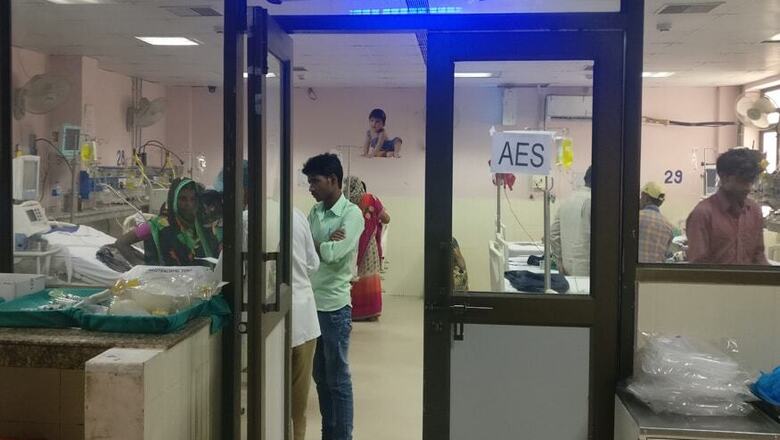
views
New Delhi: It’s not the best feeling to walk into a hospital. Things are worse if it’s a government hospital.
An old guard at the door doesn’t blink an eye even if you are physically injured. Patients, some of them in a critical condition, lie wherever they find space. Their family members huddled around them, desperately seeking staff’s attention.
But the long queue to fill up forms extends till the end of the hospital gate. Unable to find a bed, these patients and their family members often spend days outside, waiting for their number to arrive.
“The doctors said my wife may have stomach ulcer. They have given medicines, but she’s still in pain. We have come all the way from Jaipur. We don’t have a place to stay and they won’t admit my wife,” says Vishnu Bawaria, all the while caressing his wife as she moans in pain, as they sit in a little park-like area right outside Delhi’s Lok Nayak Jai Prakash Narayan Hospital. Bawaria is waiting for his wife’s diagnostic tests that would take him around a month.
It’s the easiest to blame the doctors, but it’s not quite easy to be a doctor in any of Delhi’s 38 government hospitals. Dr Rakshit Garg, the medical officer at LNJP, one of the biggest government hospitals in the city, said doctors usually spend about 14-15 hours a day in the hospital. And given the number of patients who visit the hospital, that doesn’t seem enough.
The doctor-to-patient ratio is quite appalling. “There are about six doctors in the casualty department. On an average, there are 400 patients in the morning and about 700 in the evening,” Dr Garg said.
He said junior doctors often spend about 36 hours at a stretch in the hospital: “If you are a doctor, hospital becomes your home.” And despite that, the doctors are the ones who face the brunt when patients get angry.
No safety for those who save lives
Dr Garg is not the only one to complain about the long hours and sleepless nights. Several doctors in LNJP had a similar story to share. But it’s not just the long hours that bother the doctors, it’s also fear of their own lives!
While wearing a white coat doesn’t seem like a risky job, often they end up getting hurt, bruised and attacked by the patients’ families.
A doctor from Guru Teg Bahadur Hospital said she was once threatened with rape when she couldn’t attend to one of the patients. “I was attending to a number of patients that day. This man, out of nowhere, comes to me and starts screaming,” she said. The man then told her “I will tear your clothes right here and rape you.” The doctor was scared. And this is not a one-off story.
Dr Sejal Sudhakar Bhangle, who works at the department of Surgery in LNJP, said the system is very patriarchal. “The patients will often call us ‘sister’ instead of ‘doctor’. They feel a woman can’t be a doctor. It is extremely insulting,” she said.
The doctor pointed out there is barely any security system in place at government hospitals. Dr Bhangle, who has been working in the hospital for about two years now, said the hospitals had employed bouncers a couple of months back. But, soon they were replaced with old guards who are not ‘skilled’.
“Sometimes we feel we have to protect the guards,” she said.
Dr Garg remembers several incidents when the doctors and guards have been attacked. “Government hospitals don’t have checks in place. There are no metal detectors unlike private hospitals. People can walk in with anything they want,” he said.
Though most public hospitals have closed circuit television cameras to monitor the events, these have helped very little except to record evidence of attacks. No wonder over 75% of doctors across the country are reported to have faced at least some form of violence, estimates Indian Medical Association.
The doctors have demanded that, like private hospitals, public hospitals should allow only a few relatives to accompany a patient to a hospital. But it hasn’t worked out like that. “Most of the patients who come here are poor. There’s that emotional factor at play. If they are checked, they will immediately shout saying they are not thieves,” said Dr Garg.
The government had set up an inter-ministerial committee in 2015 to examine such issues and evaluate ways to ensure safety of those who save lives. In its recommendations, the panel had suggested the health ministry to initiate the process to bring a central law. The proposed law may have stringent provisions like making any act of violence against a doctor, medical professional or hospital authority a non-bailable offence.
Do what Netas say
The nexus between politics and healthcare system in the country makes it worse for both the patients and the doctors. While a doctor at the hospital tries to explain the mystery of the missing ICUs to this reporter, a man walks up to him, with a letter in hand. The letter is from Imran Hussain, Delhi’s minister of food and civil supplies, environment & forests. He has written to the PRO medical director, asking him to ensure that “his patient” be taken care of and given a bed in one of the Intensive Care Units (ICUs). The doctors had to immediately leave the work and attend to the neta’s orders.
“This happens on a regular basis. We get calls from the politicians telling us that we need to make exceptions and speed-up the process for their patients. This leads to the poor people, who come here with no political reach, suffer more,” a doctor said.
Another doctor mentioned about the time when one of the ministers called him and asked him to admit a relative in the ICU. When the doctor said there were no empty beds in the ICU, and he would have to ‘kill someone’ to grant the politician his wish, the neta’s response was: “I don’t care.”
LNJP has about 83 ICUs across various departments. But, they are never empty.
Dr Vivek Chouksey, president, Federation of Resident Doctor's Association (FORDA) that works for the welfare of resident doctors, said, on a regular day you will find 3-4 patients huddled up in one bed. “Most hospitals don’t even have the basic equipment,” he said. “Some hospitals don’t even have drinking water,” the doctor said, highlighting the terrible healthcare system in the country.
Chouksey, too, said that political pressure makes it worse for the common man.
Three-year wait for MRI scan
In every corner of LNJP hospital, Arvind Kejriwal’s banners have been plastered on the walls. Last year, the Delhi chief minister launched a helpline number 1031 for patients and their relatives in government hospitals to report any kind of lapses in the policies of free medicines, tests and surgeries.
On an average, the nodal officer, who is on duty 24X7, gets about 15 calls a day, often in the middle of the night. Once the call centre informs him about a complaint registered, he has to call the complainant directly. Once he knows the problem, he has to solve it within the next 10 minutes.
Turns out, most of the complaints are about long queues and the non-availability of medicine.
“Patients travel a lot and then if we tell them that medicines are not available, they will be agitated,” a senior doctor said. “There are supposed to be nine pharmacies open all the time. But we don’t have the staff for that. How can we solve this problem unless more people are hired?”
In Lok Nayak hospital, only one MRI machine is functional. This is shared by the patients referred by all the 34 government hospitals. Struggling to meet the high demand, patients are asked to come back for the MRI scan after three years. While the government has installed MRI machines in other hospitals too, most of them have broken down with lack of care and excessive use. Naturally, this leads to a lot more complains.
Doctors in need of a ‘Dost’
The rate of suicidal deaths among doctors is 2-4% as against about 1-2% among the general population. The work pressure, longs hours, and the stressful nature of the job are among the reasons. However, despite the studies, there’s practically zero intervention or help from the government or the administration.
“You see a lot of pain, and that affects you considerably. And to top it all, there’s no time to take bath for days, forget relaxation,” said Apeksha, an intern at Lok Nayak hospital. Apeksha, along with other undergraduate students at Maulana Azad Medical College have started a social group called ‘Dost’. They have sent out questionnaires to the future doctors so students who need early intervention can be identified.
‘Dost’ holds a meeting every fortnight with its volunteers to figure out how they can improve communication with each other to ease out the work pressure. “During my stay at the college hostel, there were two suicides. But there were no counsellors,” Apeksha said. ‘Dost’, she says, is trying to change this.
Recently, after 15,000 resident doctors across all the state-run hospitals protested against the government’s decision to increase the OPD registration timing, it was finally reduced by an hour. And for the first time, it resulted in a 45-minute lunch break for the doctors. “Previously, doctors did not have lunch break timings during OPD sessions,” the FORDA President said. The OPD registration timings are now 7.30 am to 12 noon. However, the OPD clinics function as usual from 8 am to 2 pm.
As Dr Garg says, “it’s fragile, skeletal system running the show”.


















Comments
0 comment